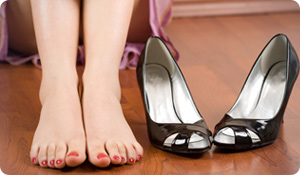
Nothing spoils your day faster than aching feet. Happy feet, however, create a foundation for wellbeing from the ground up. We've got five tips for keeping your feet in tip-top shape and pain-free.
1. Don't go barefoot outside. The risks for stepping on something sharp, rough, hot or icky are too high. The skin on our feet isn't tough. Instead, its extreme sensitivity acts as a protective device so we'll avoid burning, stubbing, scraping and puncturing our feet.
2. Keep feet clean and well groomed. Follow these simple grooming tips to make sure your feet are in the best condition possible.
- Wash daily with soap and water
- Buff away dry, dead skin that can turn into calluses or painful cracks
- Clip nails in a straight line to avoid ingrown nails
- Moisturize dry areas and powder sweaty shoes
- Wear clean socks
- Be careful about professional pedicures. Infections can spread easily from the last person who soaked in the footbath or used the clippers to you.
- Bring your own file, clippers, cuticle pushers, brushes and pumice stone.
- Don't let your pedicurist cut your cuticles or use a callus shaver.
- Be certain the footbath is meticulously cleaned between users.
3. Wear the right shoes. Your feet perform different jobs during your day and your shoes should support them. The American Podiatric Medical Association (APMA) says, "An average day of walking brings a force equal to several hundred tons on them. They are subject to more injury than any other part of the body, underscoring the need to protect them with proper footwear."
- Athletic shoes. They're all a little different. For example, walking shoes have different features than running, tennis or basketball shoes but all should provide ample room for your toes, arch support and padding for your heels and the balls of your feet. Replace worn shoes regularly to be certain their protective features are in good condition.
- Work shoes. Make them appropriate for what you ask your feet to do all day and consider occupational requirements like closed toe shoes, low heels, steel reinforced toes and sturdy heels.
What about fashion?
Even podiatrists recognize that stylish, beautiful shoes are an irresistible temptation. APMA recommends men and women avoid narrow-toed shoes and that women limit the amount of time they spend in high heels because they shift weight and pressure to the balls of your feet and toes. Keep heel height under two inches and alternate with sneakers or flats. Invest in "walking" pumps that offer athletic shoe-derived construction, reinforced heels and wider toe room for work and dressy occasions.
4. Baby your self. No two sets of feet are alike and not everyone can wear the same styles.
- Have a professional shoe fitter take a look to determine whether you have neutral, high or low arches and recommend the appropriate shoe for your arch type. Consider having orthotic arch supports made or ask an athletic shoe professional about off-the-rack arch supports.
- Cushion the balls of your feet and heels. Look for shoes with built-in padding or add gel or foam insoles. APMA has lists of footwear products they endorse, including specific brands for shoes, orthotics and insoles.
5. Get some exercise. Losing weight, doing warm up exercises and stretching after exercise are important ways to take a load off your feet, which carry the weight of the whole rest of your body.
- Extra weight causes a flattening of the foot and strain on the band of tissue that runs from the heel to the base of the toes. This can cause plantar fasciitis, a primary cause of heel pain.
- People carry approximately four to six times their body weight across the ankle joint when climbing up stairs or walking steep inclines. Obesity significantly increases the impact.
Preventing foot pain is especially important for diabetics and people with circulatory problems. If you're already experiencing foot pain, see your primary care physician or a podiatrist.
Sources
http://www.nlm.nih.gov/medlineplus/ency/article/003183.htm
American Podiatric Medical Association
American College of Foot and Ankle Surgeons
http://www.foothealthfacts.org/
American Orthopedic Foot and Ankle Society





